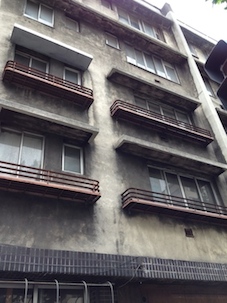List of Authors
>>About this blog
Recent blog post
|
[wombat]
June 30, 2014 15:00
Following the last time, this time we will take a walk in bold letters.
Tsukishima Station (Makudonaldo Tsukishima store): The power stone of Tsukuda Namiwa Inari Shrine: Tsukuda Kobashi, Obori Pillars ... Tsukuda Island ferry
Site: Sumiyoshi-jinja Shirine ... Gosei Kawayanagi, Mizutani Ryotei stone monument ... Tsukuda Park ... Ishikawajima Lighthouse Remains ... River City 21 ・ Ishikawashima Park / Paris Square ... Japan's first private Western-style shipyard birthplace ... Seawaterhouse ruins ... battery ruins ... Tsukishima Nakadori Yumeya
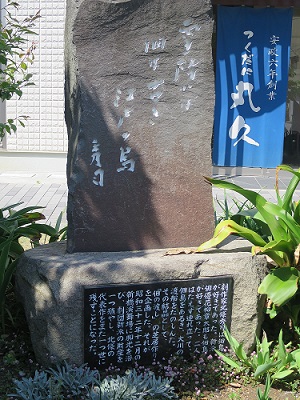
The playwright Shuji Hojo loves Tsukuda with Shotaro Hanayagi.
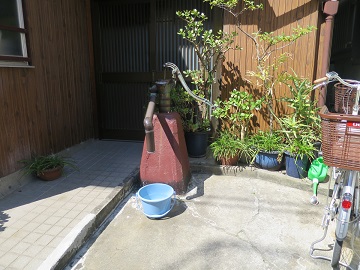
An old well of a house in front of the gate of Sumiyoshi-jinja Shirine. I'm still using it. The new school "Tsukuda's handover" is famous. The new school "Tsukuda's handover" is famous. 
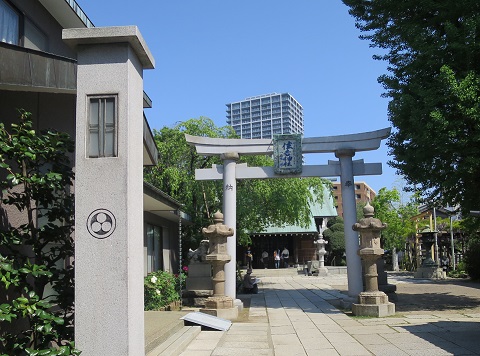
Sumiyoshi-jinja Shirine. The flat is made of pottery. It is baked in a clear blue color by the dyed brush of Prince Arisugawa Miyanobori.

The octagonal portable shrine imitates the throne of the Emperor's ceremony.
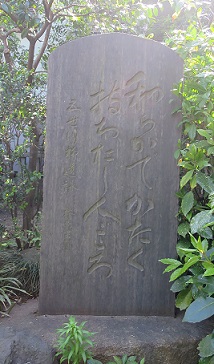 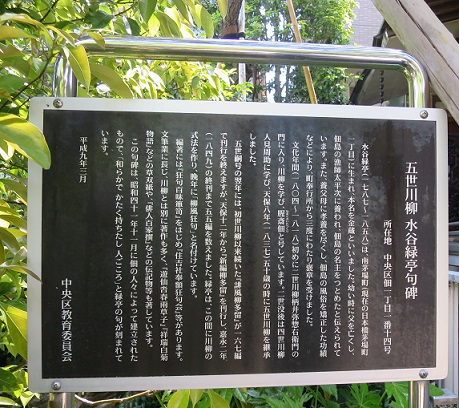
Kawayanagi, Mizutani Ryotei stone monument. "I was worried about Tsukuda's customs and discussed his ideas, and worked hard to correct them. Inside the shrine.
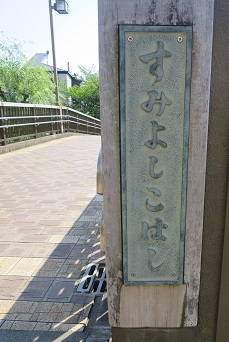 Mr. Yoshiko Sumi Mr. Yoshiko Sumi
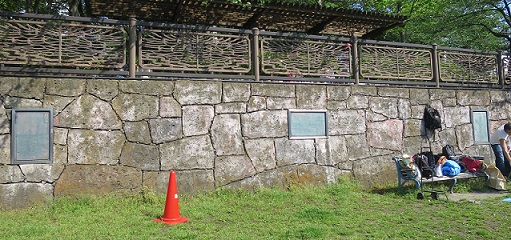
A relief of ukiyo-e from Hiroshige Utagawa on the entire revetment of Tsukuda Park. Top 100 Views of Edo "Tsukuda Shima Sumiyoshino Festival"
The thirty-six views of Fuji "Oki Tsukuda Oki" and the Tokyo detailed picture "Tsukuda Island Tomeiji Shimoshioboshi" convey the scenery of the past.
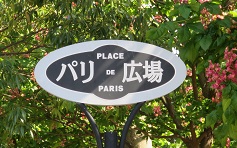 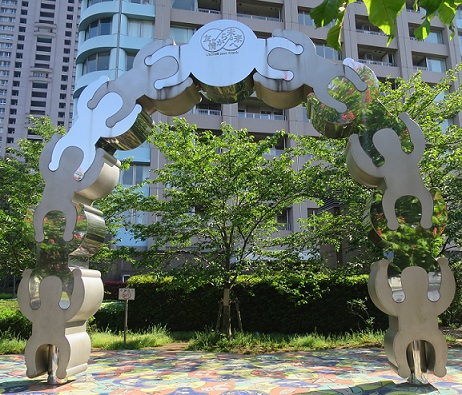
Established in 1999. Thanks to the construction of Tokyo Square in Paris, it was built in Super dike on the Sumida River. A monument to "From Friendship to the Future."
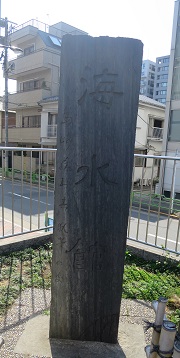 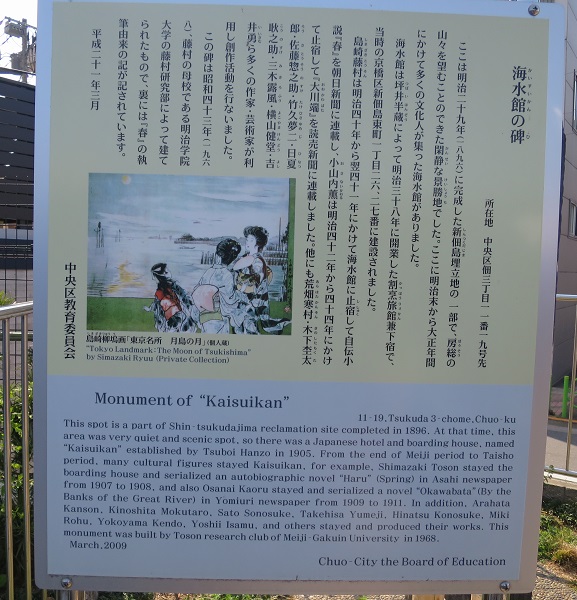
The ruins of Kaikaikan. It was destroyed by the Great Kanto Earthquake. In Isamu Yoshii Utashu and Poison Rabbit, "If you look at the winter sea, Sorrow and Shin-Tsukuda Kaisuikan will be a wabi-live."
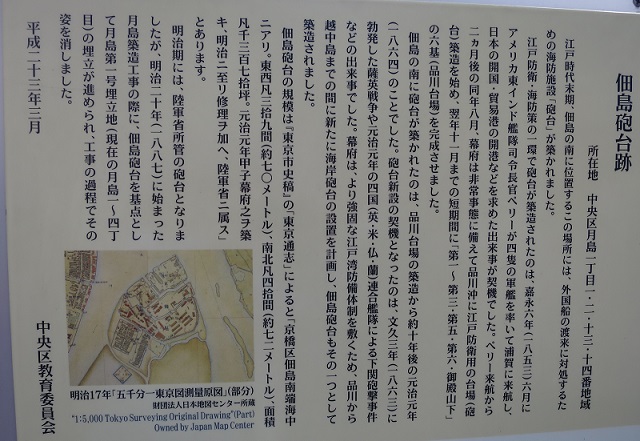
This is a little far away from the entrance of Tsukishima Monja Nakadori, and few people notice it.
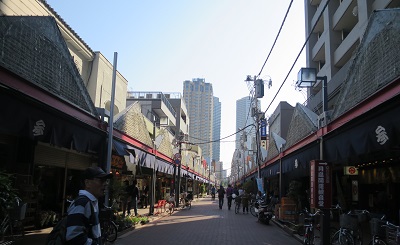
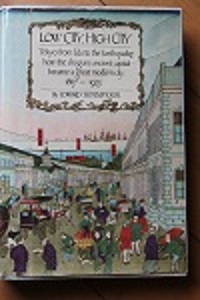 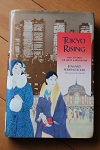
Well, at the end, it's delicious monjayaki, okonomiyaki and yakisoba
I drank and ate a lot and finished the day today.         
[Shiraji]
June 26, 2014 14:00
Ginza, the largest luxury commercial area in Japan, had many alleys until the Showa 30s.
There are quite a few wooden houses on the back street, and wooden houses must be built at least 50 cm away from the border under civil law, so there is inevitably a gap of more than 1 m. There were many residents, so in fact, a private road, that is, an alley, was built more than that of the convenience of life.
However, since it is a land that was said to be "Soil Issho Kin Issho", the wooden houses were more and more destroyed or burned down by fire (at this time there were many fires). Building has been built.
Non-combustible buildings are built in contact with buildings, so the alleys, which are private roads, were absorbed by new buildings and disappeared.
At that time, the private road was the property of the landowner, and the people who passed there seemed to be inevitable if the landowner built a building and could not pass the alley, so if you built a building, it was natural to build a building on the site.
At present, it is said that even private roads, people who use them on a daily basis have the right to pass, and private roads cannot be closed without permission. To put it difficult, there is a precedent that the right to pass on a private road can be obtained at the time of acquisition, and that right (passing ground role) can compete with the landowner without registration. In other words, even landlords can't close or crush private roads without permission.
Well, such a difficult story is that there are still back streets where old wooden buildings still remain, and alleys left in consideration of convenience even when it becomes a building, and there are hidden luxury bars in it, and there are izakayas for office workers.
This time, let's introduce one of them, the alley of Ginza 8-chome.
There is an alley that runs from Kinharu Street to Namiki-dori St. on Ginza 8-chome, sandwiched between Hanatsubaki Street and Gomon Street, which is a luxury social hall. There is an alley that was called "Success alley" by senior officials and elite office workers.
In the past, it used to continue from Ginza Street, but because the space between Ginza Street and Kinharu Street is too narrow and dangerous, now a locked door is installed and cannot pass.

So now, the entrance near the famous sushi restaurant "Kubei" on Kinharu Street is the starting point (marked by my French), passing through the alley lined with bars, and then passing through the alley with "Porsche Building" on the left, it will be Namiki-dori St., ahead of which will be a large road rather than an alley.
     
If you go straight through Sotobori-dori St. and JR elevated tracks and cross Hibiya Street, you will eventually reach Kasumigaseki and hit National Diet Building. (Approx. 15 to 20 minutes)
It was located in Ginza 8-chome, and if you go straight on the path that became wider and wider, it would have been called the "good alley" because it hit National Diet Building, the pinnacle of Japanese politics.
Well, in fact, it was also called "Obi Yokocho" because drunks often do tubs in dim alleys ... (laughs).
[whatever]
June 25, 2014 09:00
This building is located along the Shin-ohashi-dori St.. It may be noticed by many people. When I look for the entrance, it says "Shokin Apartment". It seems to be read as "Shokin Apartment". Every time I passed, I was looking at it while saying "It's old", honestly "I'm bored." There's nothing wrong with me. It's rather friendly. I would like to support the old building, still do my best.
According to the investigation, it seems that it was built in 1931, and it was recruited until a few years ago. That said, it didn't seem to be inhabited by people, but there were restaurants on the first floor, and there was a sense of life. Certainly until around April of this year ... built in 1931, and it was recruited until a few years ago. That said, it didn't seem to be inhabited by people, but there were restaurants on the first floor, and there was a sense of life. Certainly until around April of this year ...
In June, I had twice had the opportunity to pass in front of the building, but it seems that the situation was different from before ... maybe most of the stores on the first floor have been closed.
Of course, I think it has been renovated several times, but has that also reached its limit? Is it destined to be demolished?
The first two photos were taken in April of this year. The third photo was taken in June.
Before April, I feel like there was a store where products were lined up on the sidewalk side ...
There's a small veranda on the 2nd or 3rd floor.
The elevator doesn't seem to be installed.
On the 4th to 5th floors, the floor plan is different, or the window seems to be a little smaller.
How long have you been using it?
The signboard of the shop still remains. Maybe you're still in business here...
***
Chuo-ku, where old and new are still mixed. I will continue to take care of this building.
A deposited apartment
1-17-6, Shintomi, Chuo-ku
[Taro Edo]
June 24, 2014 18:00
Walking around the city of Ginza, I was walking around.
On the wall of the construction site in Ginza Matsuzakaya
The scenery of Ginza was introduced in Nishiki-e.
Here's one of them.
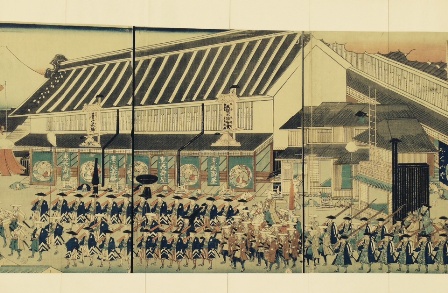
A map of Edo famous Obari-cho
Yoshimune Utagawa painting
1863 (Bunkyu 3)
It depicts the appearance of the 14th Shogun Shigeru, who passes in front of a kimono shop in Owaricho.
Owaricho is around the current Ginza 5-6 chome.
Exhibit :Chuo Ward Local Tenmonkan (Time Dome Akashi)
[Kenken]
June 24, 2014 14:00
One of my favorite things is to go around the city early in the morning by MY chari (bicycle).
On this day, we had a "chari walk" in the so-called "Nihonbashi Seven Lucky Gods" in the neighborhood of Ningyocho.
Even if you say "Seven" Fukujin, you go around a total of eight shrines. It seems that there are two shrines dedicated to Ebisu, so it seems that it is regarded as more thankful.
Koami Shrine enshrines Fukurokuju and Benzaiten because it departs from home before 5 o'clock and is first located closest to home. There is "Senrai Benten" on the left side after entering.
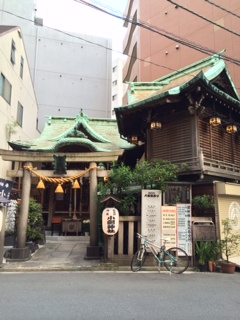
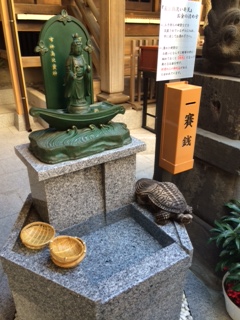 
From Koami Shrine, go semi-clockwise, next is Chanogi Shrine. You are worshiping Hotei-sama.
This is the atmosphere of a shrine in the middle of the city, a valley of buildings.
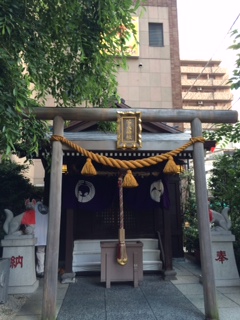
Tengu Shrine, which enshrines the third Benzaiten and is famous for giving birth and giving birth to children, has been temporarily relocated near Hamacho Park due to new construction.
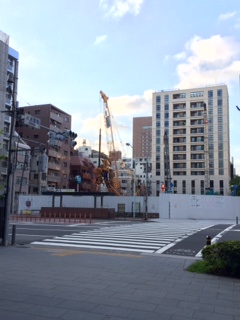
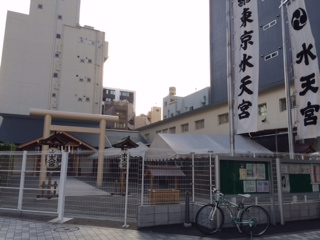
Matsushima Shrine (Otori Shrine), which enshrines great power gods, is just a shrine in the middle of the city. The first floor of the building is a shrine.
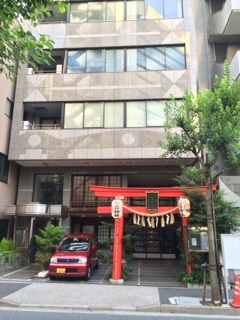
Suehiro Shrine, which enshrines Bishamonten, is particularly beneficial for fighting and avoiding disasters.
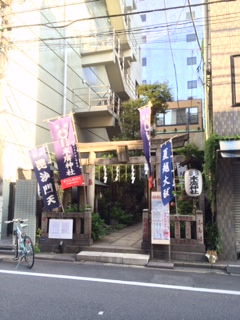
It is said that the sixth Kasama Inari Shrine was separated from Hitachi Kasama Shrine, the three major Inari shrines at the end of the Edo period. It worships the god of longevity, Kotobukijin.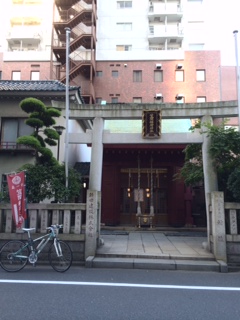
Sugimori Shrine worships Ebisu God. This shrine was also famous as a place for lottery performances, which was popular during the Edo period. It seems that the proceeds were used for the renovation of shrines and temples even though it is a lottery.
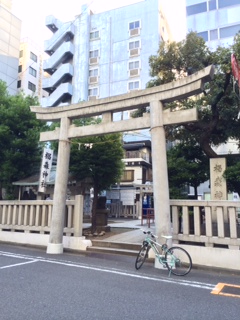
This is the 8th place to walk around Ningyocho in the early morning by bicycle. Takarada Ebisu Shrine is also a shrine dedicated to Ebisu God.
Ebisu God, located in the center of altar, said, "It is said to be a work of Unkei or Jingoro left and is worth a look!" I looked into it, but the door of the altar was closed tightly (laughs).

"Nihonbashi Seven Lucky Gods" goes around by bicycle. It was a quick turn in less than 2 hours, is there any benefit? I think it will have some effect on exercise....。
On the next occasion, I would like to ask you slowly one by one.
[Grandpa]
June 23, 2014 09:00
June 15 (Sun) Morning weather
Before the Japanese national team's match at the Soccer Festival  World Cup World Cup
The voltage is gradually starting to rise throughout Japan.
In Chuo-ku, "Happy Shopping Ticket" will be released from 9:00 am
At the sales place, there was a great success with a long line of inhabitants.
The population of Chuo-ku has been increasing year by year since 1998 (approximately 72,000).
It seems that there are now more than 135,000 people!
I feel that the line of this "happy shopping ticket" is getting longer year by year.
I also lined up in line from 8:00 am, but around 8:30 am
I didn't know where the last tail was ...
Thank you very much.
Daytime weather on the same day
After a break, the next destination is Nihonbashi Chuo-dori.
On the same day, visit the Sanno Festival's portable shrine procession "Shitamachi Union imperial procession"
When I arrived a little early, I was able to see the unusual scenery.
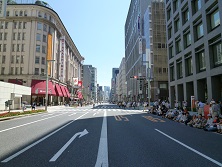 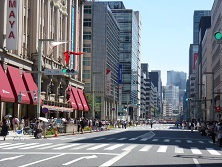
※Chuo-dori is refreshing due to traffic restrictions.
It was quite refreshing to see from around Nihonbashi 2-chome to near Kyobashi.
After that, people who excite the festival and portable shrine came one after another.
As expected, the world's festival is crowded.
We were blessed with the weather and enjoyed our holiday in Chuo-ku.
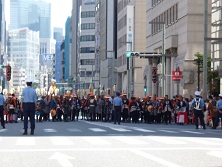 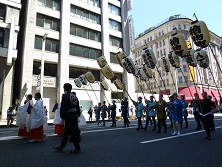
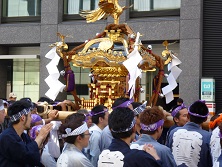 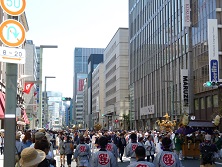
|
Links
|
![]() The new school "Tsukuda's handover" is famous.
The new school "Tsukuda's handover" is famous.![]()
![]()
Mr. Yoshiko Sumi
![]()
![]()
![]()
![]()
![]()
![]()
![]()
![]()
![]()
![]()
![]()
![]()
![]()
![]()







